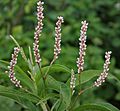Cephalophilon facts for kids
Quick facts for kids Cephalophilon |
|
|---|---|
| Scientific classification | |
| Kingdom: | |
| (unranked): | |
| (unranked): | |
| Order: | |
| Family: | |
| Tribe: |
Persicarieae
|
| Genus: |
Cephalophilon
|
| Species: |
C.capitatum
|
| Binomial name | |
| Cephalophilon capitatum (Buch.-Hamilton ex D.Don) Tzvelev
|
|
| Synonyms | |
|
|
Cephalophilon is a group of flowering plants that are part of the Polygonaceae family, also known as the knotweed family. These plants were once considered a section of another genus called Persicaria. However, a plant expert from Pakistan recently studied them again and decided they are unique enough to be their own separate group, or genus.
Contents
What is Cephalophilon?
The name Cephalophilon refers to a specific group of plants. These plants are known for their small, dry fruits called achenes. These achenes are similar in shape and structure to those found in another plant group called Koenigia. This similarity helped scientists decide that Cephalophilon should be a distinct genus.
Where Do These Plants Live?
Plants in the Cephalophilon genus are found in various parts of the world. For example, Cephalophilon capitatum, often called Pink-head knotweed, is a well-known species. It is native to parts of Asia, including the Himalayas and China. It has also spread to other areas around the globe.
What Do They Look Like?
Cephalophilon plants are typically small, often growing low to the ground. They can have pretty flowers, like the Pink-head knotweed, which has distinctive pink, globe-shaped flower heads. Their leaves can vary in shape and size depending on the specific species.
Why is This Genus Special?
The story of Cephalophilon becoming its own genus is a good example of how plant taxonomy works. Taxonomy is the science of classifying living things. Scientists constantly study plants to understand their relationships better. Sometimes, after careful research, they decide that a group of plants previously thought to be part of a larger group is actually unique enough to have its own classification. This process is called "revalidating" a genus. It means the genus was recognized before, but then later grouped with others, and now it's recognized as separate again.
Images for kids
See also
 In Spanish: Persicaria para niños
In Spanish: Persicaria para niños







